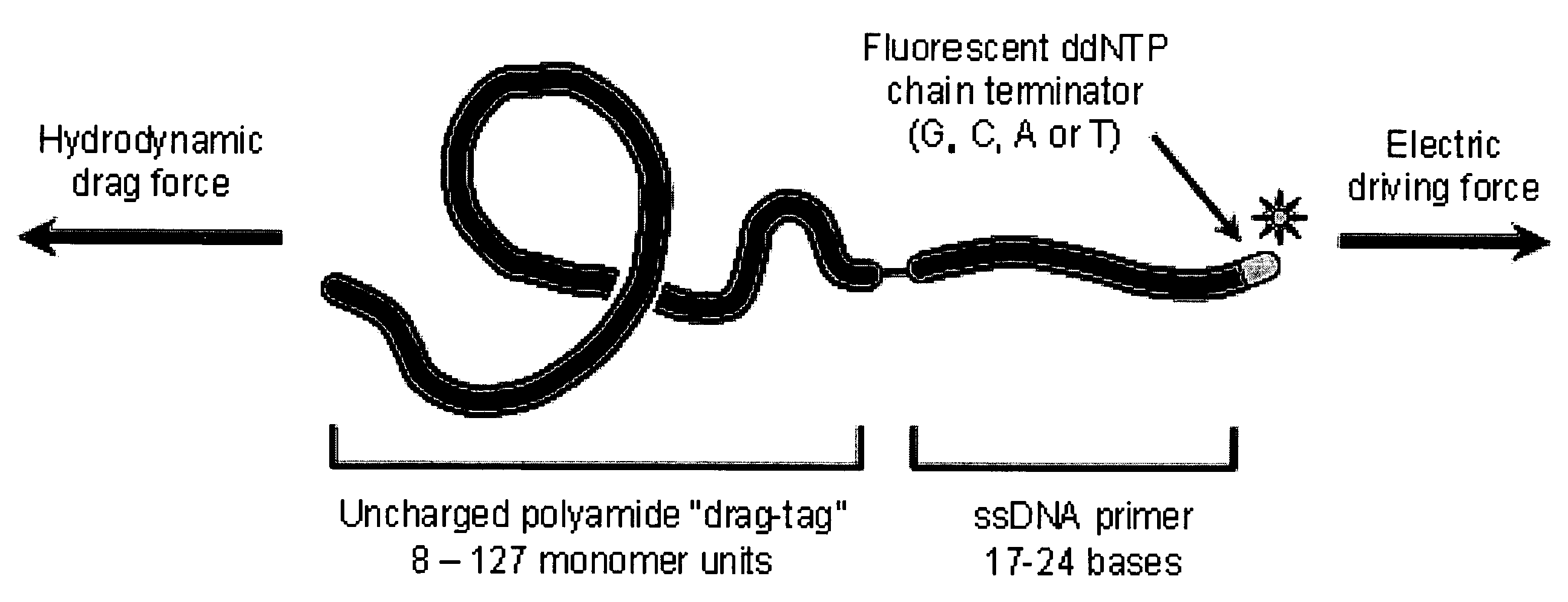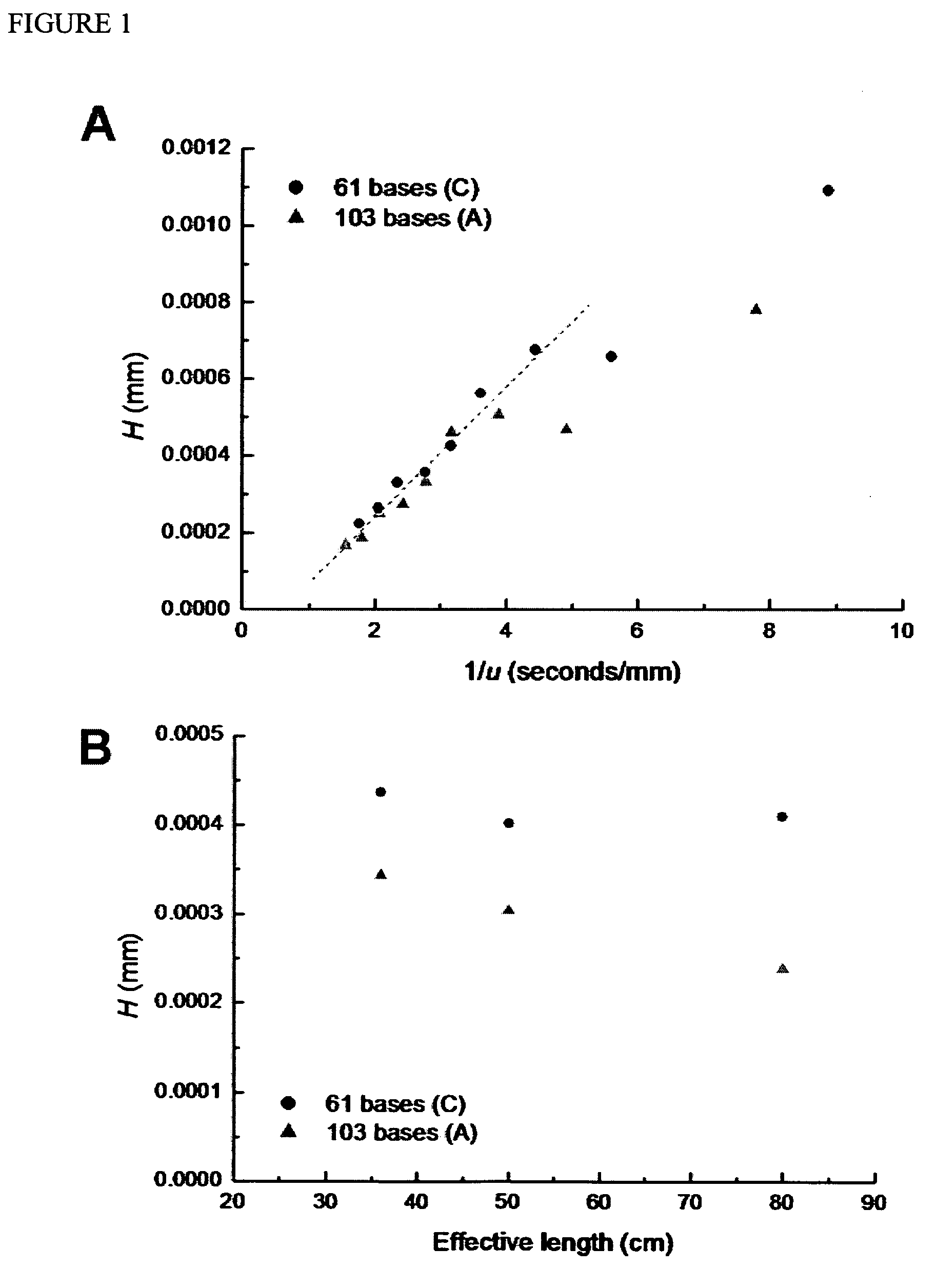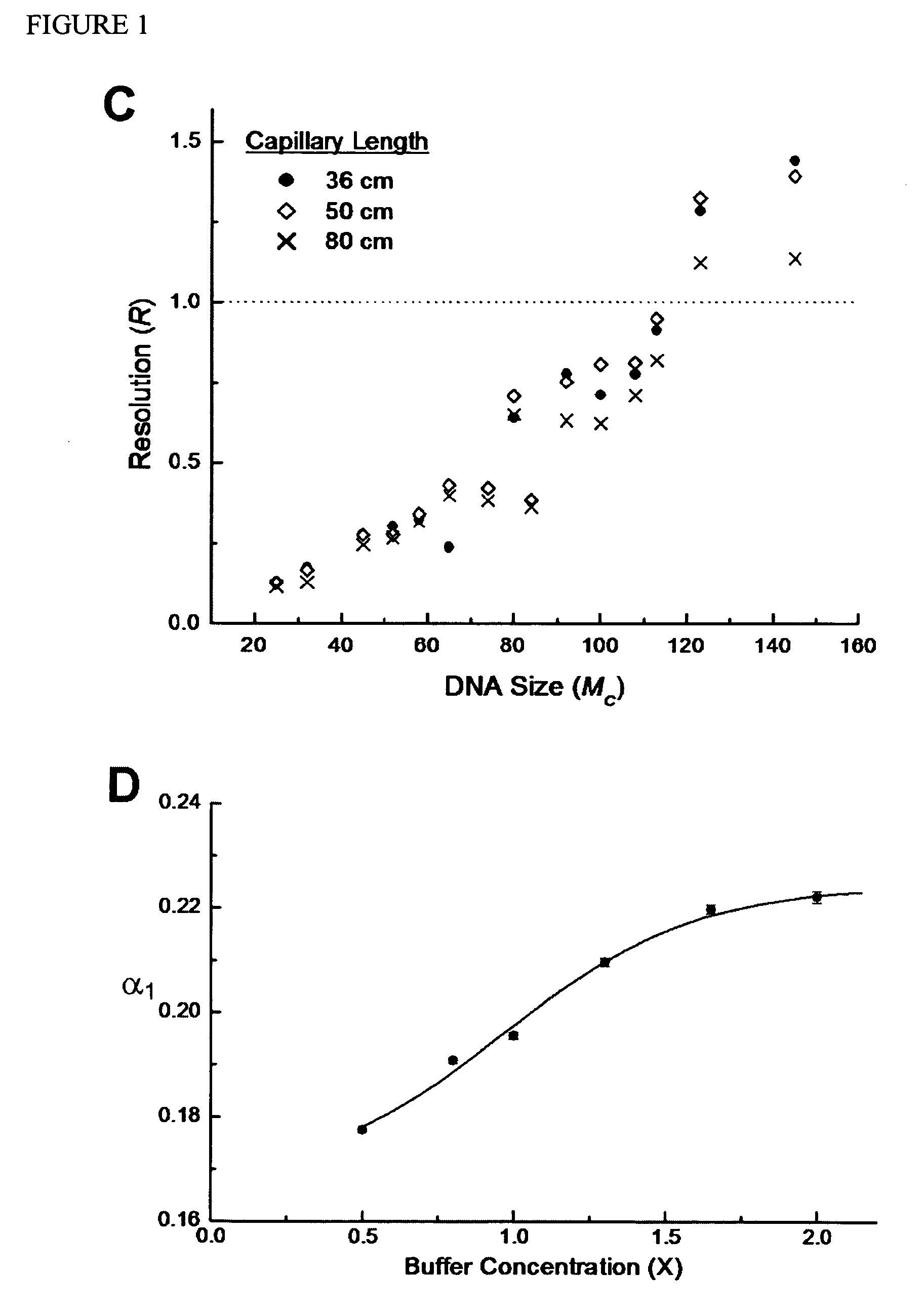Nucleic Acid Sequencing In Free Solution Using Protein Polymer Drag-Tags
- Summary
- Abstract
- Description
- Claims
- Application Information
AI Technical Summary
Benefits of technology
Problems solved by technology
Method used
Image
Examples
example 1
Production of Protein Polymer Drag-Tags
[0048]A synthetic oligonucleotide encoding for three repeats of the amino acid sequence (Gly-Ala-Gly-Thr-Gly-Ser-Ala) was purchased from Oligos Etc (Wilsonville, Oreg.), and multimerized using the controlled cloning process as previously described (J. I. Won, R. J. Meagher, A. E. Barron, Electrophoresis 26, 2138 (2005); I. Won, A. E. Barron, Macromolecules 35, 8281 (2002); J. I. Won, R. J. Meagher, A. E. Barron, Biomacromolecules 5, 618 (2004)). A multimer encoding 18 repeats of the amino acid sequence was cloned into a modified pET-19B plasmid, isolated and expressed as a fusion protein with an N-terminal polyhistidine tag in E. Coli. The fusion protein was recovered from the bacterial cell lysate by immobilized metal affinity chromatography (IMAC) using a nickel chelating resin (Probond, Invitrogen, Carksbad, Calif.). The N-terminal polyhistidine tag was chemically cleaved using cyanogen bromide in 70% formic acid, and the cleaved protein was...
example 2
Conjugation of Drag-Tag to DNA Sequencing Primer
[0049]The protein polymer was activated at the N-terminus with Sulfo-SMCC by adding a 10:1 molar excess of Sulfo-SMCC to 1.2 mg of the protein in 80 μL of 100 mM sodium phosphate buffer, pH 7.2. The mixture was vortexed for 1 hour, and excess Sulfo-SMCC was removed using a Centri-Sep gel filtration column (Princeton Separations, Adelphia, N.J.). The purified, activated drag-tag was frozen and lyophilized, then resuspended in pure water at a concentration of 10 mg / mL.
[0050]A 17 base, thiolated M13 (−40) forward sequencing primer (5′-X1GTTTTCCCAGTCACGAC (SEQ ID NO:3), where X1 is a 5′-C6 thiol linker) was purchased from Integrated DNA Technologies (Coralville, Iowa). The 5′-thiol group was reduced by incubating 2 nmol of the DNA with a 20:1 molar excess of TCEP at 40° C. in a total volume of 20 μL of 70 mM sodium phosphate buffer, pH 7.2, for two hours. The reduced oligonucleotide was desalted with a Centri-Sep column, and immediately mi...
example 3
Sequencing Reactions and Cleanup
[0051]DNA sequencing reactions were carried out using the SNaPshot Multiplex single-base extension (SBE) kit (Applied Biosystems, Foster City, Calif.), with deoxyribonucleotide triphosphates (dNTPs) added to facilitate Sanger sequencing instead of single-base extension. Five μL of the SNaPshot premix was mixed with 8 nmol dNTPs (1.8 nmol dCTP, 1.8 nmol dTTP, 2.2 nmol dGTP, and 2.2 nmol dATP), 4.2 μmol of drag-tag-labeled primer, and 0.16 μg of M13mp18 control DNA template (Amersham Biosciences, Piscataway, N.J.) in a total volume of 10 μL. The reaction was cycled in a MJ Research Products Thermal Cycler, with 26 cycles of denaturation at 96° C. for 5 seconds, annealing at 50° C. for 5 seconds, and chain extension at 60° C. for 30 seconds. Upon completion of thermal cycling, the reaction products were purified using a Centri-Sep column (Princeton Separations, Adelphia, N.J.) to remove residual buffer salts, dNTPs, and chain terminators. The purified pr...
PUM
| Property | Measurement | Unit |
|---|---|---|
| Electric charge | aaaaa | aaaaa |
| Length | aaaaa | aaaaa |
| Time | aaaaa | aaaaa |
Abstract
Description
Claims
Application Information
 Login to View More
Login to View More - R&D
- Intellectual Property
- Life Sciences
- Materials
- Tech Scout
- Unparalleled Data Quality
- Higher Quality Content
- 60% Fewer Hallucinations
Browse by: Latest US Patents, China's latest patents, Technical Efficacy Thesaurus, Application Domain, Technology Topic, Popular Technical Reports.
© 2025 PatSnap. All rights reserved.Legal|Privacy policy|Modern Slavery Act Transparency Statement|Sitemap|About US| Contact US: help@patsnap.com



